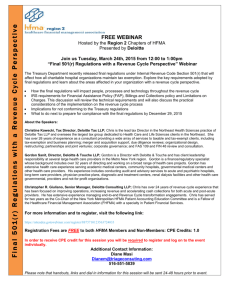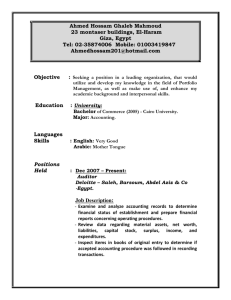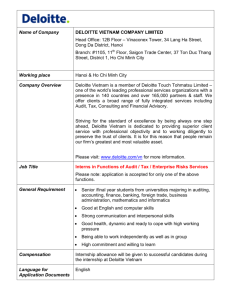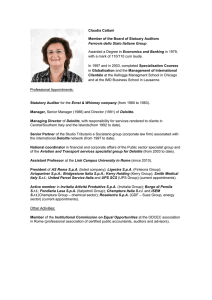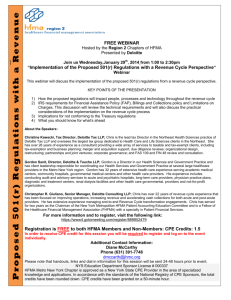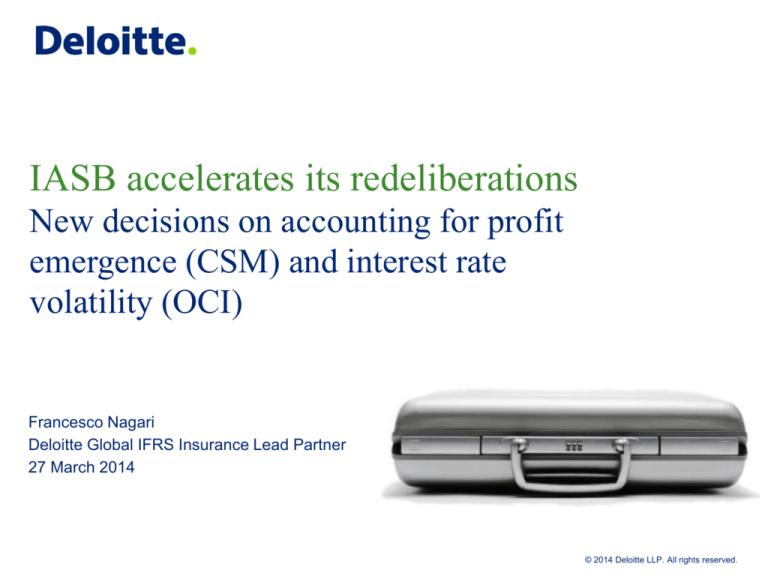
IASB accelerates its redeliberations
New decisions on accounting for profit
emergence (CSM) and interest rate
volatility (OCI)
Francesco Nagari
Deloitte Global IFRS Insurance Lead Partner
27 March 2014
© 2014 Deloitte LLP. All rights reserved.
Agenda
• Highlights of decisions from IASB meeting in March
• Detailed analysis of the IASB Staff recommendations and Board
discussions
• Update on timetable and next steps
© 2014 Deloitte LLP. All rights reserved.
Highlights
• IASB meeting on 18 March 2014
• Preceded by an education session on the same topics on 13 March 2014
• Profit emergence – CSM accounting has been retained but amended
• Interest rate volatility – OCI solution has been made optional
• Next steps
3
IFRS 4 Phase II Webcast (March 2014)
© 2014 Deloitte LLP. All rights reserved.
Overview of discussions
Redeliberation of accounting for changes in estimates
The IASB considered two of the five targeted proposals in its Exposure Draft
issued in June 2013, which deal with how entities would account for changes in
estimates:
•
•
The unlocking of the contractual service margin (CSM)
Presenting the effect of changes in discount rates in other comprehensive
income (OCI)
The IASB considered only insurance contracts that have no participating
features
4
IFRS 4 Phase II Webcast (March 2014)
© 2014 Deloitte LLP. All rights reserved.
Unlocking the contractual service margin
Should the CSM be adjusted for differences between current and previous
estimates of the present value of cash flows relating to future coverage or
other services?
Staff Recommendation
•
•
5
The difference between the current and previous estimates of the PV of cash
flows related to future coverage and other services should be added to, or
deducted from, the CSM, subject to the CSM not becoming negative.
Differences not related to future coverage and other future services should be
recognised immediately in profit or loss.
IFRS 4 Phase II Webcast (March 2014)
© 2014 Deloitte LLP. All rights reserved.
Unlocking the contractual service margin (cont.)
Complexity
•
The staff noted the importance of operational complexity with unlocking/locking,
and that the decision should be based on benefits achieved.
Benefits
•
•
•
•
Unlocking would increase consistency between the CSM accounting on day 1
and day 2.
Results in better representation of the CSM as the unearned profit in a contract.
Consistency in measurement under the Building Block Approach (BBA) and the
Premium Allocation Approach (PAA)
The staff noted concerns expressed by commentators about the definition of
‘portfolio’. The level of aggregation for the CSM and unlocking will be addressed
at a future IASB meeting
Disadvantages
•
The main criticism of unlocking is the lack of transparency from recognising
changes in estimates through earnings
•
This could be mitigated by the reconciliation requirements
6
IFRS 4 Phase II Webcast (March 2014)
© 2014 Deloitte LLP. All rights reserved.
Unlocking the contractual service margin (cont.)
Unlock only for changes relating to future coverage
Adjustment to the margin only for changes relating to future periods should be
made
•
•
Margin represents unearned profit that the entity would earn by providing
coverage/other services in the future.
The proposal is consistent with IAS 8:
i.
Changes in estimates that have incurred are recognised in the current
period
ii. Changes in estimates for future periods to be recognised in the respective
future periods
•
This proposal was supported by most respondents to the 2013 ED.
IASB vote
The IASB unanimously reconfirmed the proposal in the 2013 Exposure Draft
captured in the staff recommendation
7
IFRS 4 Phase II Webcast (March 2014)
© 2014 Deloitte LLP. All rights reserved.
Treatment of previously recognised losses
Whether to treat the favourable changes in estimates of the PV of cash flows by:
A. Recognising favourable changes in profit or loss up to previously recognised
losses in profit or loss, with any excess changes used to re-establish the CSM
B. Re-establishing the CSM immediately
Staff Recommendation
•
•
•
8
Favourable changes in estimates that arise after losses were previously
recognised in profit or loss should be recognised in profit or loss to the extent
that they reverse those losses
Any excess should be used to re-establish the CSM
Arguments for this change suggest that the benefits outweigh the costs of a
more complex accounting system
IFRS 4 Phase II Webcast (March 2014)
© 2014 Deloitte LLP. All rights reserved.
Treatment of previously recognised losses (cont.)
Should previously recognised losses be reversed?
For
•
•
•
If previously recognised losses are not reversed in profit or loss, a margin can
be rebuilt for a contract that is considered to be loss making overall
Consistent with the IAS 37 treatment for previously recognised losses on
onerous contracts
Increases consistency between gains and losses, hence increases consistency
between entities that report quarterly and those that only report annually
Against
•
•
9
Simplicity: Reversing previously recognised losses would require the entity to
track cumulative losses
Transparency: Users would find it difficult to distinguish the amounts
recognised in profit or loss in the reporting period. They would need to know
historical losses in order to analyse the gains arising from the reversal of losses
IFRS 4 Phase II Webcast (March 2014)
© 2014 Deloitte LLP. All rights reserved.
Treatment of previously recognised losses (cont.)
IASB vote
The IASB unanimously agreed with the staff recommendation.
The decision reached on 18 March 2014 changes the 2013 ED, which
proposed to re-establish the margin immediately i.e. previously recognised
losses would not be reversed in profit or loss via the recognition of a gain in
subsequent periods
10
IFRS 4 Phase II Webcast (March 2014)
© 2014 Deloitte LLP. All rights reserved.
Unlocking CSM for changes in the risk adjustment
Should the CSM be unlocked for changes in the risk adjustment?
Staff Recommendation
•
•
11
Differences in the current and previous estimates of the risk adjustment that
relate to coverage and other services for future periods should adjust the CSM,
subject to the CSM not becoming negative
Changes in the risk adjustment that relate to coverage and other services in
current and past periods should be recognised immediately in profit or loss
IFRS 4 Phase II Webcast (March 2014)
© 2014 Deloitte LLP. All rights reserved.
Unlocking CSM for changes in the risk adjustment (cont.)
Benefits
Consistency
•
•
Increases consistency of the margin – that the CSM should represent the
margin after adjustment for risk both on initial recognition and subsequently.
The differences in current and previous estimates of risk adjustment should be
treated consistently with the changes in current and previous estimates of the
PV of cash flows to which the risk adjustment relates
Practicality
•
12
The feedback indicates that decomposing the risk adjustment between the part
related to future coverage and that related to current and past coverage is
practical, as existing methods for determining the risk adjustment already
make this information available.
IFRS 4 Phase II Webcast (March 2014)
© 2014 Deloitte LLP. All rights reserved.
Unlocking CSM for changes in the risk adjustment (cont.)
Concerns
•
•
Recognising changes in the risk adjustment in profit or loss could result in
losses being recognised in one period even when the contract is profitable
overall.
This could give more room for management manipulation, as the determination
of the risk adjustment is highly subjective and it is affected by the entity’s
assessment of the price of the risk.
IASB vote
The IASB unanimously agreed with the staff recommendation.
The IASB confirmed that a risk adjustment and a separate CSM provide useful
information to users of the financial statements.
The decision reached on 18 March 2014 changes the 2013 ED, which
proposed to recognise changes in the risk adjustment in profit or loss instead
of unlocking the CSM.
13
IFRS 4 Phase II Webcast (March 2014)
© 2014 Deloitte LLP. All rights reserved.
Deloitte proposed amendments
Remove the requirement for the CSM to be earned over the
coverage period. Instead, the release of the CSM to profit or loss
should be over the duration of the insurance contract such that it
covers both the coverage and the claims handling period as the
handling of claims is a key service to the policyholder
•
•
•
14
CSM should be released based on the pattern of transfer of services under
the contract (inclusive of the pattern of release from risk).
Handling of incurred claims and the uncertainty surrounding incurred claims
is within the definition of an insurance contact.
The proposal to differentiate accounting for the CSM between claims
handling and other services results in ambiguities.
IFRS 4 Phase II Webcast (March 2014)
© 2014 Deloitte LLP. All rights reserved.
Deloitte proposed amendments (cont.)
Remove the restriction by which CSM unlocking for changes in
future cash flows that relate to future coverage and other future
services.
•
The proposed restriction would require insurers to identify cash flows
associated with insurance risk or risk associated with other future services
and to separate them from those affected by financial and other risks. The
identification process would be difficult to perform and could lead to
divergent application.
Require prospective changes in the risk adjustment to be
accounted for in the CSM in a similar way as the changes in future
cash flows.
•
15
If the CSM was unlocked for all changes in cash flows expected in future
periods the change in the risk adjustment recognised in profit or loss would
reflect the expiry of risk for in-force contracts and the release from contracts
that have been derecognised in the period.
IFRS 4 Phase II Webcast (March 2014)
© 2014 Deloitte LLP. All rights reserved.
The new OCI solution
Should the effect of changes in discount rates be presented in OCI or profit
or loss?
Staff Recommendation
•
•
Develop an option for insurers to present the effect of changes in discount
rates in P&L or in OCI as an accounting policy choice at the portfolio level.
Develop disclosures that provide information about the effect of changes in
discount rate during the period
Which items could be included in OCI?
•
•
•
16
Bridging items The difference between the measurement inconsistency of
assets and liabilities in profit or loss and in the statement of financial position.
Mismatched re-measurement This arises when an income or expense item
represents the effect of only part of a linked asset, liability or a past or planned
transaction. This would result in the item providing limited information about the
return on an insurer’s economic resources in the period.
Transitory re-measurement These assets and liabilities have a long-term
horizon for realisation or settlement.
IFRS 4 Phase II Webcast (March 2014)
© 2014 Deloitte LLP. All rights reserved.
The new OCI solution (cont.)
Concerns
Economic mismatches
•
•
Economic mismatches would be evident in total comprehensive income and in
the statement of financial position
Over time users of financial statements would begin to place more weight on
the information in the OCI.
High operational burden
•
Locked-in discount rates are already used for accreting interest on the CSM
and for determining the present value of future cash flows in unlocking the
CSM.
Accounting mismatches
•
17
Accounting mismatches could be avoided through the use of the fair value
option in the revised IFRS 9 and to mitigate this problem.
IFRS 4 Phase II Webcast (March 2014)
© 2014 Deloitte LLP. All rights reserved.
The new OCI solution (cont.)
Should the entities be given an option to present the effect if changes in
discount rates in profit or loss or in OCI?
Staff Recommendation
•
An entity should have an option to present the effect of changes in discount
rates in profit or loss or in OCI, and should apply a consistent policy to all
contracts within a portfolio.
Option
•
•
•
18
Operational complexity An option would justify operational complexity
because the costs of presenting an amount in OCI only where opted would
outweigh its benefits.
Accounting mismatches Providing an option would be consistent with
allowing entities to consider the factors contributing to their respective costbenefit analysis.
Earnings management IAS 8 would restrict the circumstances in which an
entity can change its accounting policy and would require relevant disclosure
where there has been a change in accounting policy.
IFRS 4 Phase II Webcast (March 2014)
© 2014 Deloitte LLP. All rights reserved.
The new OCI solution (cont.)
Unit of account
•
•
•
•
19
Strategies for assets backing insurance contracts are driven by differences
between portfolios of insurance contracts hence an option applied to portfolios
of insurance contracts should reduce accounting mismatches.
Insurance contracts and associated assets are managed at a more aggregated
level than an insurance contract, hence an option also needs to be at a more
aggregated level.
Such an approach would be consistent with the IAS 16, IAS 38 and IAS 40
application to groups or classes of items.
The IASB queried whether the portfolio level suggested by the staff was at too
granular a level to be used as the unit of account
IFRS 4 Phase II Webcast (March 2014)
© 2014 Deloitte LLP. All rights reserved.
The new OCI solution (cont.)
IASB vote
The IASB agreed with the staff recommendation.
Twelve IASB members agreed with the decision whereas three disagreed.
The decision reached on 18 March 2014 changes the 2013 ED, which
proposed the mandatory use of OCI to present the effect of changes in
discount rates on the measurement of insurance contracts.
The Chairman requested the staff to develop the wording to ensure that
discipline would be applied to the option chosen and subsequent changes in
the option.
20
IFRS 4 Phase II Webcast (March 2014)
© 2014 Deloitte LLP. All rights reserved.
Deloitte proposed amendment
Deloitte believes that an irrevocable, unconstrained designation
should be made available at initial recognition of an insurance
contract for the accounting treatment of the associated interest
expense
•
•
21
This proposal is paramount in promoting consistency and comparability across
reporting periods and market participants
The ‘OCI solution’ should not be required as this depends to a significant extent
on the asset-liability management strategy the insurer has selected and how its
financial instruments will be accounted for under ‘IFRS 9 with OCI’
IFRS 4 Phase II Webcast (March 2014)
© 2014 Deloitte LLP. All rights reserved.
New OCI solution – disclosures
Which disclosures would enable users to compare the effect of changes in
discount rates between entities that present the effect in profit or loss to
those that present the effect of changes in OCI?
Staff Recommendation
•
Additional disclosures are considered necessary for users to understand how
interest expense and changes in discount rates are recognised
All Portfolios
Disclose an analysis of total interest expense included in total comprehensive
income disaggregated into:
•
•
•
Amount of interest accretion determined with current discount rates.
Effect on insurance liabilities of discount rates changes in the period
•
•
22
Difference between the PV of changes in expected cash flows that adjust the
CSM in the reporting period, measured using:
Locked-in discount rates and
Current rates
IFRS 4 Phase II Webcast (March 2014)
© 2014 Deloitte LLP. All rights reserved.
New OCI solution – disclosures (cont.)
Portfolios with effect presented in OCI
•
•
Interest accretion at the locked-in discount rate, and
The movement in OCI for the period.
Concerns about complexity
•
Additional disclosures will not lead to significant incremental effort in
determining expected cash flows and the application of locked-in discount
rates, as these would already form part of most analyses of movement on the
PV of future cash flows that should typically be performed as a control over
measurement accuracy.
IASB Tentative Decision
The IASB agreed with the staff recommendation.
Fourteen IASB members agreed with the decision whereas one disagreed.
The decision reached on 18 March 2014 changes the 2013 ED by adding
some new disclosures
23
IFRS 4 Phase II Webcast (March 2014)
© 2014 Deloitte LLP. All rights reserved.
The next steps
Future meetings
The IASB will meet on 22-25 April
It intends to address the main issues relating to insurance contracts revenue
presentation and to consider approaches to other issues raised in the
responses to the 2013 ED.
Issues specifically related to participating contracts will be considered at a later
stage.
Reconsideration of tentative decisions
Once issues relating to participating contracts have been addressed the staff
will consider whether tentative decisions reached for non-participating
contracts need to be revisited.
Decisions of the IASB become final only after completion of a formal ballot to
issue a final standard.
24
IFRS 4 Phase II Webcast (March 2014)
© 2014 Deloitte LLP. All rights reserved.
Contact details
Francesco Nagari
Deloitte Global IFRS Insurance Lead Partner
+44 20 7303 8375
fnagari@deloitte.co.uk
@Nagarif
Deloitte Insights into IFRS Insurance (i2ii)
www.deloitte.com/i2ii
Insurance Centre of Excellence:
insurancecentreofexc@deloitte.co.uk
25
IFRS 4 Phase II Webcast (March 2014)
© 2014 Deloitte LLP. All rights reserved.
Deloitte refers to one or more of Deloitte Touche Tohmatsu Limited (“DTTL”), a UK private company limited by guarantee, and its network of
member firms, each of which is a legally separate and independent entity. Please see www.deloitte.co.uk/about for a detailed description of the
legal structure of DTTL and its member firms.
Deloitte LLP is the United Kingdom member firm of DTTL.
This publication has been written in general terms and therefore cannot be relied on to cover specific situations; application of the principles set out
will depend upon the particular circumstances involved and we recommend that you obtain professional advice before acting or refraining from
acting on any of the contents of this publication. Deloitte LLP would be pleased to advise readers on how to apply the principles set out in this
publication to their specific circumstances. Deloitte LLP accepts no duty of care or liability for any loss occasioned to any person acting or refraining
from action as a result of any material in this publication.
Deloitte LLP is a limited liability partnership registered in England and Wales with registered number OC303675 and its registered office at 2 New
Street Square, London EC4A 3BZ, United Kingdom. Tel: +44 (0) 20 7936 3000 Fax: +44 (0) 20 7583 1198.
© 2014 Deloitte LLP. All rights reserved.
© 2014 Deloitte LLP. All rights reserved.



